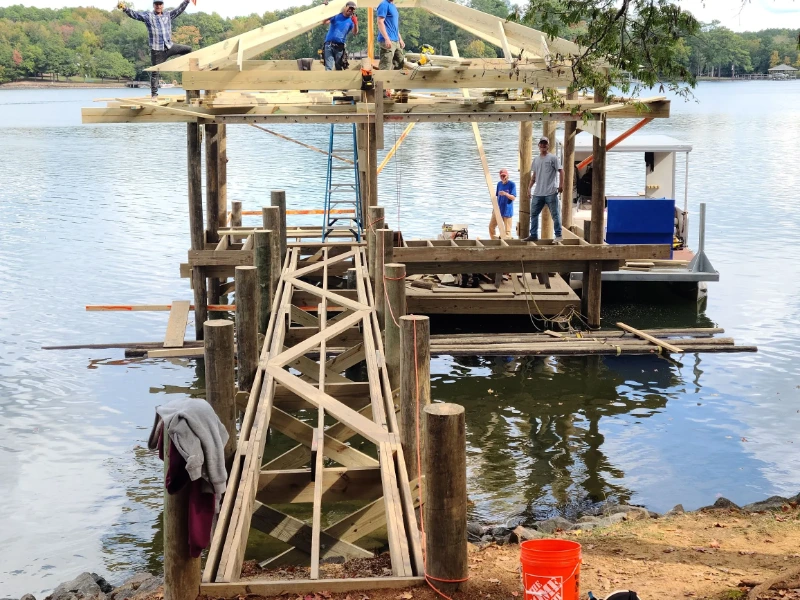How to Address Common Dock Repair Issues for Safe Water Activities

Identifying Common Dock Issues
Recognizing usual dock problems is important for maintaining the capability and security of your waterside property. Regular evaluations can help discover issues prior to they become serious, making certain both the long life of the dock and the safety and security of those that utilize it.
An additional common problem is the degradation of flotation gadgets. These tools are crucial for maintaining the dock resilient, and any damage or punctures can trigger the dock to list or sink. Routinely examining for leaks or waterlogged floats can preempt more considerable issues.
Furthermore, algae and barnacle buildup on the dock's surface can produce harmful and slippery conditions. This biofouling not just poses a risk to customers but can likewise increase the damage of the dock materials.
Finally, examining for signs of rust on steel parts is crucial. Corrosion can jeopardize the stability of the dock's structure, making it unsafe. By routinely determining these typical dock problems, you can make sure that your dock continues to be useful and safe for many years to come.
Repairing Rotting Wood
When resolving the problem of rotting wood on your dock, it is vital to act quickly to stop additional deterioration. Begin by extensively examining the whole structure to identify all impacted locations. Use a screwdriver to penetrate the wood; if it sinks in quickly, the timber is likely rotted and needs immediate interest.
Once determined, get rid of the decomposed sections using a saw or chisel. Make certain to reduce back to healthy and balanced, solid wood, ensuring you remove all endangered product. After removal, treat the remaining timber with a wood preservative to avoid future rot. This treatment will certainly aid secure against wetness, which is the primary root cause of wood decay.
Following, change the gotten rid of sections with marine-grade lumber or pressure-treated timber, which are more immune to water damages. Safeguard the new pieces with galvanized or stainless-steel fasteners to avoid corrosion. Additionally, using a water-proof sealer to the brand-new wood can provide an additional layer of defense.
Safeguarding Loose Boards
Exactly how do you guarantee your dock stays useful and secure for all its users? One vital facet is protecting loosened boards, which can otherwise pose substantial risks. Loosened boards not only raise the danger of stumbling however can likewise endanger the architectural honesty of the entire dock.

For reinstallation, make use of stainless or galvanized steel screws, as these products offer superior resistance to corrosion in marine atmospheres. Make sure the screws are long sufficient to penetrate deep into the underlying support framework, but not so long that they protrude via the dock's surface area. Pre-drilling pilot holes can aid stop the timber from splitting.
Lastly, keep a normal assessment schedule to identify and resolve any kind of brand-new concerns immediately. By safeguarding loose boards efficiently, you add to the total safety and security and longevity of your dock, making it a trustworthy system for water tasks.
Supporting Unstable Pilings
Guaranteeing the security of websites unstable pilings is extremely important to keeping a useful and risk-free dock. Unsteady pilings can jeopardize the whole framework, posturing significant risks to users and potentially resulting in pricey repairs. The very first step in maintaining these essential components is a complete evaluation. Check out the pilings for signs of rot, damages, or changing. Utilize a level to check for upright alignment and guarantee they are driven deep sufficient right into the substratum to offer adequate assistance.
If the pilings are discovered to be unstable, one efficient method for support is making use of added bracing. Cross-bracing with treated lumber or galvanized metal can dramatically improve stability. Support the dental braces securely to both the pilings and the dock structure to distribute tons uniformly.

Routine upkeep and routine review of the pilings' security are crucial to ensuring long-term dock safety and functionality.
Replacing Rusty Equipment
Resolving unstable pilings is simply one facet of preserving a dock's integrity; another crucial concern is changing rusty equipment. Gradually, exposure to moisture and salt can result in the oxidation and rust of screws, screws, and brackets, endangering the whole structure's security. Normal inspection for rust is vital, particularly after severe weather or seasonal changes.
When rusty hardware is determined, immediate action is needed. Begin by choosing marine-grade stainless steel or galvanized equipment, both made to resist the severe aquatic setting. Make sure that you have the appropriate i was reading this tools, such as screwdrivers and wrenches, to securely get rid of the old, corroded items without creating additional damages to the dock.
After removing the corroded equipment, thoroughly tidy the influenced areas to remove any recurring rust or debris. Apply a rust-inhibiting primer to subjected steel surface areas prior to installing the new hardware. Tighten all components firmly to avoid future helping to loosen, and occasionally examine the installations to guarantee ongoing stability.
Replacing corroded equipment not just extends the dock's life expectancy yet additionally significantly improves the safety and security of water tasks. By proactively handling rust, you secure both the structure and its individuals, guaranteeing a delightful and protected beachfront experience.
Final Thought
Routine inspections and upkeep are necessary to deal with common dock fixing problems and guarantee safe water tasks. Such positive measures contribute to the general safety and security and capability of dock structures, promoting a secure atmosphere for water-based tasks.
Making sure the safety and security of water tasks hinges dramatically on the appropriate maintenance and repair work of docks (Dock Repairs). These devices are necessary for maintaining the dock buoyant, and any damages or leaks can cause the dock to checklist or sink. By regularly determining these common dock issues, you can ensure that your dock remains protected and why not try here practical for years to come
Guaranteeing the stability of unstable pilings is paramount to preserving a functional and secure dock.Routine inspections and upkeep are essential to resolve usual dock repair work issues and make certain secure water tasks.